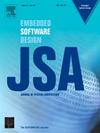Efficient adaptive bandwidth allocation for deadline-aware online admission control in centralized time-sensitive networking
IF 4.1
2区 计算机科学
Q1 COMPUTER SCIENCE, HARDWARE & ARCHITECTURE
引用次数: 0
Abstract
With the growing demand for dynamic real-time applications, online admission control for time-critical event-triggered (ET) traffic in Time-Sensitive Networking (TSN) has become a critical challenge. The main issue lies in dynamically allocating bandwidth with real-time guarantees in response to traffic changes. This also demands rapid responsiveness, scalability, and efficient resource utilization for online applicability. To address this challenge, we propose an online admission control method for ET traffic based on a combined asynchronous traffic shaper (ATS, IEEE 802.1Qcr) and credit-based shaper (CBS, IEEE 802.1Qav) architecture. This method provides a flexible framework for real-time guaranteed online admission control, supporting dynamic bandwidth allocation and reclamation at runtime without requiring global reconfiguration, thus improving scalability. Within this framework, we further integrate a novel strategy based on network calculus (NC) theory for efficient and high-utilization bandwidth reallocation. On the one hand, the strategy focuses on adaptively balancing residual bandwidth with deadline awareness to prevent bottleneck egress ports, thereby improving admission capacity. On the other hand, it employs a non-trivial analytical result to reduce the search space, accelerating the solving process. Experimental results from both large-scale synthetic and realistic test cases show that, compared to the state-of-the-art, our method achieves an average 44% increase in admitted flows and an average 92% reduction in admission time. Additionally, it postpones the occurrence of bottleneck egress ports and the first rejection of admission requests, thereby enhancing adaptability.
集中式时间敏感网络中基于截止日期感知的在线准入控制的有效自适应带宽分配
随着动态实时应用需求的不断增长,时间敏感网络(TSN)中时间关键事件触发(ET)流量的在线准入控制已成为一个严峻的挑战。主要问题在于动态分配带宽,并保证实时响应流量变化。这还需要快速响应、可伸缩性和有效的资源利用来实现在线应用。为了解决这一挑战,我们提出了一种基于异步流量整形器(ATS, IEEE 802.1Qcr)和基于信用的整形器(CBS, IEEE 802.1Qav)体系结构的ET流量在线许可控制方法。该方法为实时保证在线准入控制提供了灵活的框架,在运行时支持动态带宽分配和回收,无需全局重新配置,从而提高了可扩展性。在此框架内,我们进一步整合了一种基于网络演算(NC)理论的新策略,用于高效和高利用率的带宽再分配。一方面,该策略注重自适应平衡剩余带宽和截止日期感知,防止出口端口出现瓶颈,从而提高准入容量;另一方面,它采用非平凡的分析结果来减少搜索空间,加快求解过程。大规模合成和实际测试用例的实验结果表明,与最先进的方法相比,我们的方法平均增加了44%的允许流量,平均减少了92%的允许时间。延迟了瓶颈出口端口的出现和首次拒绝进入请求,增强了适应性。
本文章由计算机程序翻译,如有差异,请以英文原文为准。
求助全文
约1分钟内获得全文
求助全文
来源期刊

Journal of Systems Architecture
工程技术-计算机:硬件
CiteScore
8.70
自引率
15.60%
发文量
226
审稿时长
46 days
期刊介绍:
The Journal of Systems Architecture: Embedded Software Design (JSA) is a journal covering all design and architectural aspects related to embedded systems and software. It ranges from the microarchitecture level via the system software level up to the application-specific architecture level. Aspects such as real-time systems, operating systems, FPGA programming, programming languages, communications (limited to analysis and the software stack), mobile systems, parallel and distributed architectures as well as additional subjects in the computer and system architecture area will fall within the scope of this journal. Technology will not be a main focus, but its use and relevance to particular designs will be. Case studies are welcome but must contribute more than just a design for a particular piece of software.
Design automation of such systems including methodologies, techniques and tools for their design as well as novel designs of software components fall within the scope of this journal. Novel applications that use embedded systems are also central in this journal. While hardware is not a part of this journal hardware/software co-design methods that consider interplay between software and hardware components with and emphasis on software are also relevant here.
 求助内容:
求助内容: 应助结果提醒方式:
应助结果提醒方式:


